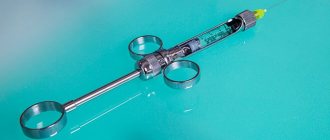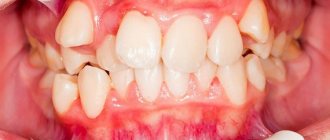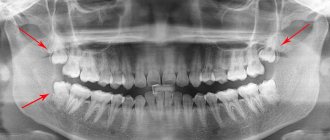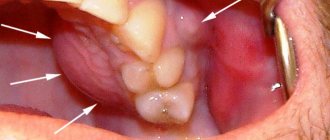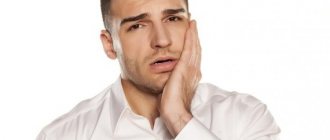In the practice of dentists, there are often cases when a patient’s tooth is fully formed, but does not erupt. It is called “retained”, and the problem is treated with special methods. Teeth that are formed but “stuck” inside the jaw can cause inflammatory processes: pericoronitis, periodontitis, periostitis, abscess, phlegmon, etc. Treatment is carried out using various methods, from removal to wearing specialized braces. Reduce the risk of impacted tooth Prevention helps, for example, wearing trainers that prepare the jaw for the appearance of new teeth.
What is retention? Why does pathology develop? Symptoms and diagnosis
Retention is considered one of the most common teething anomalies. Most often, problems arise with the lower and upper “wisdom teeth”, which grow incorrectly. They are usually encountered by adults. In children, a common impacted tooth is the canine of the upper jaw. The second premolars of the mandible often present unpleasant surprises.
Symptoms of unerupted teeth vary by owner. The problem may not manifest itself at all, or it may cause constant visits to the dentist. The variety of symptoms and their absence is due to the fact that the incorrect position of a tooth or its incomplete eruption is an almost natural phenomenon for humans. Approximately 35-45% of “wisdom eights” in adults are impacted teeth . Difficulties begin to arise when such a molar or premolar causes irritation of the soft tissue around it. Based on indirect signs - pain or inflammation - the doctor identifies the “wrong” tooth.
Semi-retinated teeth are visible immediately at the first examination: they partially grow, but not completely. Such partially erupted molars and premolars cause many more problems: being partially located in the soft tissues, they almost always cause inflammation. There is no need to specifically diagnose them: the doctor almost always finds such teeth during a routine examination.
Finding completely impacted teeth is a real quest. They may not be visible at all, because they are located under the existing elements of the dentition. In this case, there is only one diagnostic option: you need to take a full picture of the jaw, which will clearly show the whole picture. Below in the picture is a selection of examples. Impacted teeth are marked in red or with arrows.
Examples of impacted teeth on x-ray
Symptoms
Of course, with retention, symptoms arise. Typically, a person notices general malaise, fever, redness, swelling of the gums, partial eruption, and missing teeth. If you feel the gums, pain occurs.
Partial
If the retention is partial, then you can see the top of the tooth above the gum or feel it. It is also visible thanks to the dental probe.
Full
Here the tooth is completely covered by gum. It cannot be felt or seen during an examination or examination of the oral cavity. To detect the rudiments, it is worth conducting an x-ray examination.
Types of dental retention
There are many classifications of dental retention. One of the most popular methods of division is by degree of eruption. Thus, there are semi-impacted teeth , which are partially visible in the gum, and completely hidden - located under the gum or bone tissue. The latter are not available for palpation. If the impacted tooth is located in the gum tissue, the diagnosis will say “with tissue immersion,” but if it is located in the bone, “with bone immersion.”
Another classification method takes into account the position of the molar, canine or premolar:
- vertical,
- horizontal,
- corner.
Horizontal teeth can also be transverse, sagittal or oblique, and angular teeth can be mesial, distal, lingual or buccal angular. Rarely, but still there are reverse impacted teeth - these are elements that grow “upside down”, that is, their crown is directed towards the jaw.
Causes of impacted teeth. Is it possible to prevent retention?
The most popular reason for impacted teeth is genetic predisposition. Moreover, what is inherited is not the desire of the canines and molars to grow “some into the forest, some for firewood,” but the structure of the jaw. It can be narrow, which is why there is simply not enough space for all the necessary elements of the dentition. But there are other reasons:
- malocclusion, which has formed due to harmful myofunctional habits or mechanical injuries;
- early loss of baby teeth, due to which permanent teeth do not have guidelines for growth;
- “extra” teeth – atavism, called polyodontia;
- initially diseased tooth germs.
In some cases, retention problems can be prevented. Some orthodontists and pediatric dentists recommend the use of trainers to develop the dental arch and give growing canines and molars a guideline for eruption. If the problems are hereditary, only timely treatment will help.
You can read more about trainers in the article: Trainers for straightening teeth: description, varieties, tips for use
Preventive measures
In order to avoid serious complications in the postoperative period, the patient must follow certain rules. Dentists at the Optimal Choice clinics give the following recommendations:
- Eating is allowed no earlier than three hours after tooth extraction surgery. In addition, while the wound is healing, you should avoid eating solid food.
- Drinking and eating cold, hot, and drinking alcoholic beverages is prohibited.
- During the first 24 hours you should not smoke.
- You are required to give up physical activity for several days. The same applies to excessive facial expressions and loud laughter. This must be done so that the stitches do not come apart and the healing of the wound does not slow down.
- Hot water procedures, including showers and baths, are prohibited. Of course, you cannot visit a sauna or bathhouse after surgery. Hot compresses to the cheek are also prohibited unless you want to harm yourself.
- Five minutes of cold compresses or ice applied to the cheek on the side where the removal was performed will help cope with swelling and pain.
- To brush your teeth, you should choose a toothbrush with soft bristles.
- Do not actively rinse your mouth. If it is necessary to treat the oral cavity, you should give preference to baths: take a medicinal solution into your mouth, hold it there calmly for several minutes and spit it out without effort. For this you can use a solution of chlorhexidine or furatsilin or infusions and decoctions of medicinal herbs. Oak bark promotes healing very well.
- If your doctor has prescribed you to take any medications, you must take them according to the written regimen.
Compliance with these recommendations will reduce the risk of complications to a minimum.
Why are impacted teeth dangerous?
Despite the fact that sometimes unerupted teeth do not interfere with a person in any way, you need to understand that every impacted tooth is a potential cause of serious and unpleasant diseases. They lead to the following problems:
- inflammatory processes;
- non-healing ulcers on the gums and cheeks;
- constant appearance of caries, pulpitis;
- the appearance of gum pockets, which can cause periodontitis;
- infectious processes, often leading to osteomyelitis (purulent infection of the jaws).
The absence of symptoms is almost always the result of a happy accident, and not a normal development of events. Therefore, with such a diagnosis, it is very important to constantly see a doctor.
What to do with a problem tooth
The difficulty and danger of removing a dystopic, impacted tooth lies in the fact that it is located inside the gum. Such formation is dangerous for the patient because the tooth may be subject to destruction that will be impossible to cope with.
But despite the complexity of the procedure, it is completely safe and painless for the patient. Modern dentistry is able to provide reliable anesthesia and quick results through the use of professional equipment.
Principles of treatment: is it possible to avoid surgery?
Many patients are sure that an impacted dystopic tooth is necessarily a reason for surgical intervention. But dentists try not to cut without a good reason. Therefore, if your extra teeth are not inflamed and do not interfere with your life, it is quite possible to avoid surgery. The doctor may also prescribe the installation of hard metal braces, which will “pull” the partially erupted tooth from the gum tissue and fit it into the dentition.
Typically treatment proceeds as follows:
- A diagnosis is carried out, which includes a visual examination and the creation of a panoramic image of the jaw.
- The doctor examines the results and decides whether the tooth needs to be removed. If yes, then surgery is prescribed.
- If the dentist sees other ways to solve the problem, he prefers them. First of all, the installation of a bracket system is considered. To do this, it is necessary that there is a place in the dentition where a new element could be placed.
- If braces are not required or cannot yet be placed, the doctor will try to help the tooth erupt. For this purpose, medications and surgery are used. Teething assistance is often used when the wisdom tooth is partially left under the gum, but is positioned correctly.
Modern doctors have many treatment methods in their arsenal, but everything completely depends on the specific case.
Stages of treatment for an impacted tooth
Why does a wisdom tooth grow incorrectly?
How is it that all other teeth erupt without problems, but eights cause a lot of trouble for some of their owners? There may be several reasons. The main one is, of course, the age at which wisdom teeth appear.
Unlike other permanent units, they erupt after the main stages of the formation of the dentofacial system are almost complete. In addition, in almost half of patients, such teeth become crooked at the stage of formation inside the gums.
A deformed tooth, unable to “come into the light,” begins to grow to the side or even deeper, affecting the bone tissue. Therefore, a timely visit to a doctor is necessary in any case - so as not to aggravate the situation by inaction.
The main causes of deformation of the eighth teeth are considered:
- genetic factor;
- too early replacement of temporary teeth with permanent ones;
- “extra” teeth (dentists call them supernumerary);
- jaw pathologies;
- infections and chronic somatic diseases.
When is it necessary to remove an impacted tooth? Why remove impacted teeth?
Even an experienced surgeon will say that removing an impacted dystopic tooth is a serious and complex operation that should not be performed unnecessarily. Therefore, it is indicated in the following cases:
- inflammation of the soft tissues (pericoronitis) or jaw (osteomyelitis);
- the tooth is located in a follicular cyst or grows horizontally;
- a cyst or benign formation is diagnosed;
- pus or bacterial infection is detected.
Removal technique
Removal should be carried out by an experienced doctor who knows the specifics of working with impacted teeth. The main problem here is their inconvenient location, so it’s difficult for a beginner to cope with the problem. Removal takes place in several stages:
- Performing local anesthesia (in case of complex tooth position, general anesthesia can be used).
- An incision in the mucous membrane.
- Drilling into bone tissue to create a hole.
- Tooth extraction.
- Removal of tooth or bone fragments.
- Treatment of the wound.
- Stitching.
- Sutures are removed one week after surgery.
Often, the doctor has to first crush and then remove the tooth so as not to damage the adjacent molars and mucous membrane.
Contraindications
The operation will have to be postponed for the following reasons:
- the patient's serious condition due to any kind of illness;
- hypertensive crisis;
- nervous problems or mental disorders;
- viral infections;
- blood diseases;
- serious heart problems.
For women, this operation is not performed 2-3 days before the start of menstruation and after an abortion (at least 2 weeks must pass).
What complications occur after removal of impacted teeth? How to avoid them
Any operation can cause complications, and surgical treatment of an impacted tooth is no exception. Most often, the consequences manifest themselves as severe bleeding, pain, swelling of the gums or cheeks. If nerves are affected, increased sensitivity or insensitivity of the mouth and face may occur. Due to the incorrect actions of doctors, the patient faces a dislocation of the jaw or even a fracture.
The patient can avoid problems after surgery if he goes to a trusted clinic (excluding the human factor) and carefully takes care of the wound that appears in the mouth. Immediately after surgery, the patient should:
- refuse food for 3-4 hours;
- do not smoke for at least 3 hours;
- Avoid alcohol until the stitches are removed.
It is important to come back for a follow-up appointment with a surgeon or therapist. It is necessary to monitor the bleeding: if it does not stop for too long or painkillers do not work, you should contact the dentist immediately. Timely help will help avoid unpleasant consequences.
Postoperative care after removal of an impacted tooth
The doctor is obliged to advise the patient on how to properly care for the wound on the gum. Since removing an impacted tooth is a full-fledged operation, it is imperative to follow the rules of care. The patient needs:
- reduce physical activity to a minimum for 2-3 days after surgery;
- refuse hot and cold foods and liquids;
- change your toothbrush to a soft one;
- take only a warm shower or bath, do not visit baths and saunas;
- take all medications prescribed by your doctor (antibacterial therapy is usually prescribed).
It is important not to rinse your mouth so as not to disrupt the healing. You can make neat baths (liquid or herbal decoction is taken into the mouth, held without rinsing and spitting), but coordinate all procedures with your doctor.
When will the operation have to be abandoned?
There are a number of contraindications for performing surgery to remove lower impacted “eights”:
- heart diseases;
- severe inflammation of the gums (medicine treatment with antibiotics and painkillers is initially prescribed, only after the course of treatment is completed can surgery be performed);
- fungal or infectious infection of oral tissues;
- ARVI, influenza or acute respiratory infections;
- pregnancy in the first and last trimester (the operation can be performed only if there are serious indications, in other cases it is postponed until the postpartum period);
- mental illnesses that do not allow the patient to behave adequately in the dental chair and prevent the dentist from performing an operation, etc.
The decision to remove the lowermost molar if it is impacted is made by the doctor after a thorough examination.
Conservative methods of treating retention
If the tooth is located correctly in the gum and there is minimal interference with eruption, doctors try not to remove it, but to return it to its intended place by nature. Different methods are used for this:
- laser correction;
- current pulses;
- gum massage;
- electrophoresis;
- some medicines.
All these treatment methods are aimed at making the tooth crown get rid of the gum hood on its own. They partially imitate the natural process of eruption of canines and molars. But the availability of such treatment depends on the situation.
Consequences
In the absence of proper treatment, quite serious consequences can occur:
- facial aesthetics are impaired;
- teeth located on the sides shift;
- an odontogenic cyst forms;
- the roots of the teeth in the neighborhood are reabsorbed;
- neighboring teeth erupt incorrectly.
The most common diagnosis is impacted wisdom teeth.
How to stimulate tooth eruption
Stimulating the eruption of an impacted tooth is also one of the ways to treat the problem. The doctor prescribes specialized procedures if he sees that a molar or canine is positioned correctly, but its roots have not yet formed. Then the orthodontist recommends:
- Carrying out vacuum massage with special equipment;
- light finger massage at the site of eruption;
- electrical stimulation;
- exposure to ultrasound, laser, vibrating vacuum devices, etc.
Such methods are aimed at restoring blood circulation and accelerating metabolic processes in the gums.
Cost of the procedure
In the Optimal Choice dental clinics, the cost of surgery to remove lower impacted wisdom teeth averages 5,000 - 8,500 rubles. The price may vary depending on factors such as the level of complexity of the operation, the materials and anesthesia used, and the need for additional medical procedures.
You can find out more about prices on our price list page.
Conclusions. Expert advice
An impacted tooth is a molar, premolar or incisor that is hidden in bone or gum tissue. If part of the tooth is visible, it is called semi-impacted. Many children and about 40% of adults face this problem when they lose their eights. The appearance of incorrectly positioned teeth itself may go unnoticed – the symptoms are associated with related diseases. Thus, caries in a tooth hidden in the gum almost always causes inflammation of nearby tissues.
It is believed that impacted dystopic teeth are a hereditary problem. But they can appear due to an incorrect bite. Retention can be improved using surgical intervention or conservative methods: massage, electrophoresis, etc. Some dentists recommend wearing trainers, which help develop the dental arch and reduce the risk of improper eruption.
Almost always, the orthodontist tries to return the tooth to the dentition using braces and other methods of influence. If this does not work, the doctor removes the foreign element. The operation is complex, so it is important to contact a specialist. Success largely depends not only on the doctor, but also on the patient: failure to comply with the rules of postoperative care leads to complications.
What to do if you suspect you have a similar problem? See a doctor and be constantly monitored by him. The dentist will prescribe treatment and help prevent complications.
What can a dentist offer you?
Most often, the patient goes to the dentist too late. In this case, the dystopic tooth or several adjacent to it are removed. As a rule, correcting such a defect, especially an advanced one, is very difficult, because its location in the oral cavity is somewhat atypical. To make the dentist’s work and your own fate easier, you should not delay your visit to a specialist.
It is very problematic to remove a dystopic wisdom tooth, therefore, to eliminate the defect, the tactic of removing ordinary teeth from a row is used. For example, if you go to the dentist before the age of 15, the solution to the problem will be the mildest: the least important tooth in the row will be removed.
